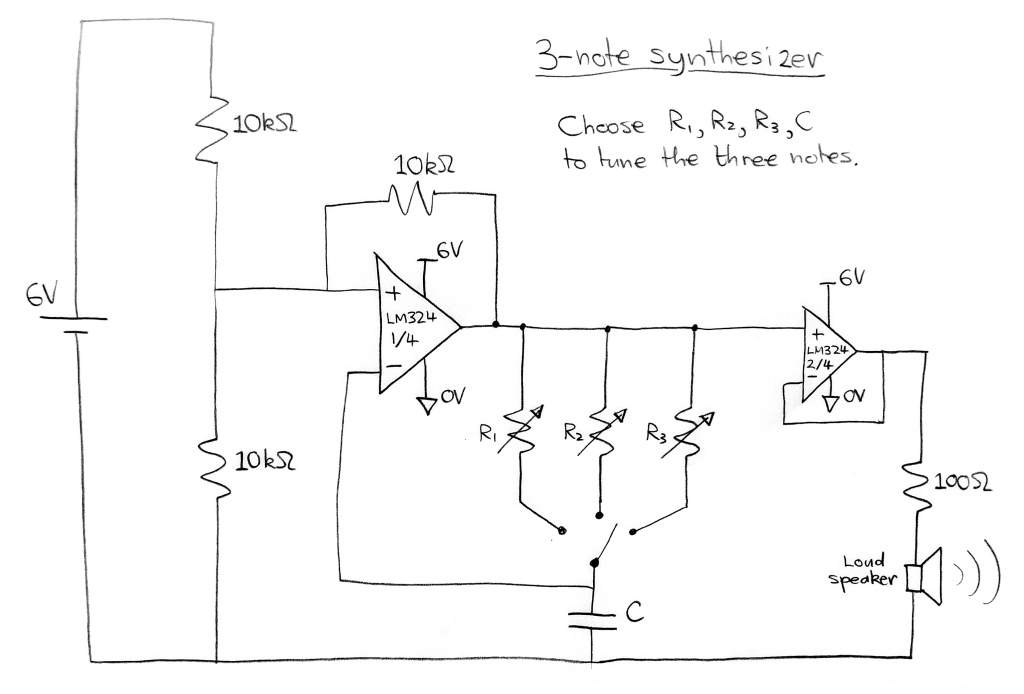Expected project duration: 2 weeks (4 lab sessions)
At the end of this project you should be able to:
- Build an voltage oscillator circuit on a breadboard using an opamp.
- Use an oscilloscope to debug and test your oscillator circuit.
- Adapt the oscillator circuit to produce musical sounds from a loudspeaker.
This project comprises two parts:
- Individual element: Initially, you will build and test a relaxation oscillator circuit on your breadboard (circuit diagram provided below). You will submit evidence of your working circuit in Brightspace (deadline Thurs 8 Dec 2022).
- Team element: You will work with your teammates to develop an analog music synthesizer that you will use to perform a piece of music for a competition in the final week of the semester (deadline Thurs 15th Dec 2022).
Further details about both elements of the project will be provided in class.
Part 1 (individual element): Build a working synthesizer circuit
Evidence to be submitted for part 1 (deadline Thurs 8th Dec 2022):
- Breadboard circuit photo: A clear close-up photograph of your neatly wired breadboard circuit. Please ensure that colour coding of wires is correct and consistent, and that all components are neatly laid out with legs appropriately trimmed to reduce the risk of short circuits.
- Sawtooth waveform photo: A clear photograph of the oscillating capacitor voltage waveform that is displayed on an oscilloscope.
- Square wave photo: A clear photograph of the oscillating opamp output voltage waveform displayed on the oscilloscope.

Part 2 (team element): Build an analog music synthesizer
Evidence to be submitted for part 2 (deadline Thurs 15th Dec 2022):
- A link to a YouTube video showing a practice performance using your team’s analog music synthsizer. One YouTube video per team. Each team member should upload the link to the video to confirm that they contributed to what the team achieved.
In the final week of the project (and the teaching term), you will work with your team to construct an analog music synthesizer, based on your oscillator circuit(s). There is no single best way of doing this, but a couple of ideas are shown below that might get you started.
We have a limited supply of small loudspeakers that can be attached to the breadboard. You will achieve a more impressive audio output if you source a larger speaker yourself, but in the meantime you can test with the provided loudspeakers.
Ideas for analog music synthesizers
This is a simple 3-note analog synthsizer.
- Plays one note at a time.
- Adjust resistances R1, R2 and R3 to tune the three notes.
- Additional resistor branches can be added to add more notes.
- Suggested value for C is 1 µF, but other values can be used.
- The second opamp (on the right in the circuit diagram) is used as a unity-gain buffer, which drives the loudspeaker with the square wave output of the oscillator.
- To produce a different timbre, try feeding the capacitor voltage signal into the unity gain buffer instead of the square wave.
- To play a tune on this synthesizer, connect a long wire to the node at the capacitor terminal and move the wire between the different resistor branches to play a sequence of notes.

This is another analog synthesizer idea, which uses an IRFZ44N MOSFET transistor to drive the loudspeaker.
- Vary R1 to control the pitch. With practice, this method can be used to play a tune.
- Vary R2 to control the volume. Don’t reduce R2 below about 100 Ω in case you burn out the loudspeaker by driving too much current through it.
